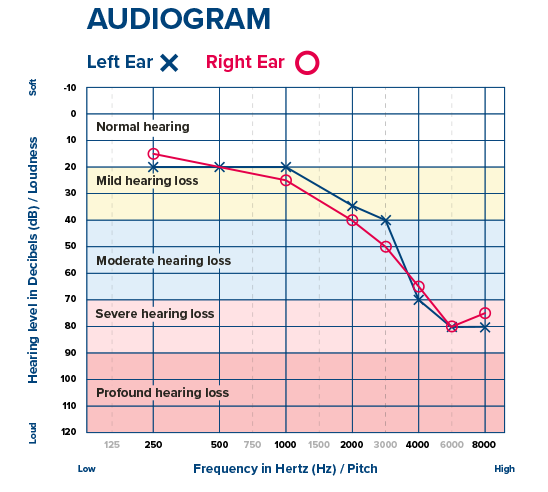Many of our hearing centres are open over Christmas. Check your local centre's opening hours and book your appointment here. Customer service & booking teams will be open on reduced hours.

Degree of hearing loss
If you think that you might have some degree of hearing loss, you’re probably wondering how serious it is. Here you’ll find information about the different levels of hearing loss and how you can seek treatment, no matter what level of hearing loss you may have.
Compare degrees of hearing loss
The severity of your hearing loss is usually measured in two ways:
- Loudness: How loud does a sound need to be in order for you to hear it?
- Pitch: Which frequencies are difficult for you to hear?
Below are the main categories for hearing loss levels with examples of sounds that might be inaudible at a given level (based on their loudness and pitch.)
| Level of hearing loss | Decibel | Symptoms | Sounds you are missing |
| Normal hearing | ≤20 dB | No perceived hearing loss symptoms | No sounds missing |
| Mild hearing loss | 21-40 dB | Quiet and soft conversation and situations with background noise are difficult to understand | Ticking clock |
| Moderate hearing loss | 41-70 dB | When you have a moderate hearing loss, the quietest sounds you can hear with your better ear are between 41 and 70 dB. Higher volume levels are required for radio and TV. | Vacuum cleaner |
| Severe hearing loss | 71-95 dB | When you have a severe hearing loss, the quietest sounds you can hear with your better ear are between 71 and 95 dB. Difficulties with speech and group conversations, comprehension is impossible without amplification. | Baby crying |
| Profound hearing loss | ≥95 dB | When you have a profound hearing loss, the quietest sounds you can hear with your better ear are 95 dB or more. Difficult or impossible to hear and understand amplified devices or speech. | Aeroplanes |
3 ways to understand the severity of your hearing loss

Online hearing test
Reading an audiogram
An audiogram is a graph or chart that displays the results of your comprehensive hearing evaluation.
The X-axis shows the different pitches of the sounds that were played to you during your test. This axis is laid out like piano keys, where low-pitched sounds are on the left and higher pitches are towards the right.
The Y-axis shows the loudness which increases as you go down the graph. The points on the graph demonstrate how loud the sounds need to be in order for you to hear at each pitch test.
Circles (red) represent your right ear and crosses (blue) represent your left ear.
Book a free hearing test to receive your own audiogram results.


Seek early treatment for hearing loss
Gradual hearing loss is fairly common in the ageing process. But this doesn’t mean that it should be ignored!
Since even mild hearing loss is associated with cognitive decline and other consequences of untreated hearing loss, all hearing loss should be treated with hearing aids or other treatment options.
Treating all degrees of hearing loss
If you think you have hearing loss but you’ve been putting off getting a hearing aid, you’re not alone.
Only 1 in 4 people who could benefit from hearing devices actually use them
Taking that first step can be the hardest part, but seeking treatment as soon as possible is important. The Scripps Research Institute has found that hearing loss, when left undiagnosed or untreated, can get worse over time. Being proactive and seeking treatment in the early stages of hearing loss can have a positive impact on your current and long-term hearing health.
5 steps to better hearing
Invisible hearing solutions
Today’s hearing aids are more technologically advanced and discreet than ever.
Some modern hearing aids are practically invisible, but they still give you excellent sound quality even in difficult listening situations.
|




